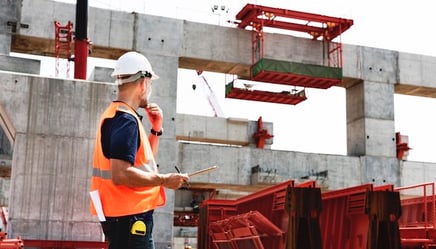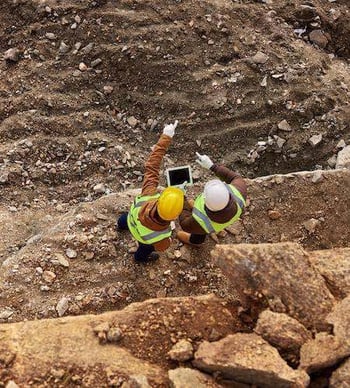Blackline Safety is a technology leader driving innovation in the industrial workforce through IoT (Internet of Things). With connected safety devices and predictive analytics, Blackline enables companies to drive towards zero safety incidents and improved operational performance. Blackline provides wearable devices, personal and area gas monitoring, cloud-connected software and data analytics to meet demanding safety challenges and enhance overall productivity for organizations with coverage in more than 100 countries. Armed with cellular and satellite connectivity, Blackline provides a lifeline to tens of thousands of people, having reported over 200 billion data-points and initiated over seven million emergency alerts. For more information, visit BlacklineSafety.com and connect with us on Facebook, Twitter, LinkedIn and Instagram.
A Guide to Lone Working Risk Assessment
Blackline Safety, Leader in Connected Gas Detection & Lone Worker Safety
August 26, 2020
 Evaluating and mitigating risks for the lone workers in your company allows you to provide protection for your most at risk employees while also ensuring you comply with regulations. To optimize your lone worker safety program, systematically assess working environments and then create targeted policies and procedures to address any hazards. This guide will provide an in-depth look to help you discern where your program is performing well, as well as determine where gaps may still exist.
Evaluating and mitigating risks for the lone workers in your company allows you to provide protection for your most at risk employees while also ensuring you comply with regulations. To optimize your lone worker safety program, systematically assess working environments and then create targeted policies and procedures to address any hazards. This guide will provide an in-depth look to help you discern where your program is performing well, as well as determine where gaps may still exist.
Additional resources:
- Our Lone Worker Risk Assessment Checklist provides a streamlined method to develop, monitor and manage your lone worker safety program.
- The UK’s Health and Safety Executive (HSE) offers a five-step process to control risk in the workplace, including for lone worker protection.
If you have questions about how to protect your lone workers through monitoring technology, please contact us online today.
Overall Risk Assessment
Assessing workplace risk involves identifying ways that workers can be harmed, analyzing your company’s current methods of addressing those hazards and then appropriately addressing the gaps. In some cases, a particular risk may apply to a wide range of lone working roles while other risks may be more job specific.
Potential risks will likely be more numerous and significant for a lone worker who performs duties in a remote outdoor location than for someone who occasionally works alone in a facility when a coworker is absent. Each situation requires risk assessment, but specifics would vary significantly.
Other examples of lone worker roles that would need a risk assessment include those who:
- Sometimes travel alone, especially in remote areas
- Sometimes work alone, either in the office or on a job site, at the start or finish of shifts
- Typically work in pairs but may be separated from the partner during the workday
- Provide on-call service after hours
- Work near other employees but in conditions that could make it difficult for them to be seen or heard when danger arises; such as worksites with physical obstructions or loud noise levels
- Work in public places and may put them in contact with people who are aggressive or even violent

After determining what lone worker situations exist in your workplace, either regularly or on occasion, you can then conduct risk assessments of each. Risk assessment teams can be created, with each member of the team having unique skill sets — for example, someone who has experience with the equipment used on an assembly line could pair up with someone with health and safety expertise. If chemicals are regularly used in the company’s processes, you could add someone to the assessment team with deep knowledge of them.
Risk assessment involves conducting a step-by-step analysis of the activities that take place and identifying those that can threaten health or cause injuries. This includes routine tasks as well as procedures that may only take place quarterly or, for example, when equipment needs to be shut down. What substances are potentially harmful? What risk factors are associated with the equipment? When is a lone worker at significant risk?
While identifying hazards, consider doing the following:
- Review manufacturer data sheets and instructions for each piece of equipment and each chemical to help influence your safety plan.
- Consider long-term hazards, such as ongoing exposure to noise or chemicals.
- Consider weather-related hazards. When temperatures rise, workers can become fatigued and dizzy, with other heat illness symptoms including muscle cramping and headaches. They can become dehydrated and even faint. If that happens in a high location, this can lead to deadly falls; when operating equipment, other dangers exist. Also, consider frostbite and other hazards of extreme cold temperatures.
- Go through the accident and ill-health records of your company to look for patterns, and then create proactive measures to help prevent future incidents.
- Have someone who is not familiar with the environment your lone workers are in review the area; familiarity can cause complacency and hazards to be overlooked.
- Ask employees for their input through surveys and interviews. Having a deep familiarity with an environment can provide unique insights.
- Observe staff as they’re working without interrupting them. Do so more than once, during different days and different shifts.
- Form focus groups to discuss risks and potential solutions.
Through this process, identify who is at risk of harm and in what ways. Also keep in mind the employees who may briefly enter workspaces, such as those delivering boxes or mail, or those who troubleshoot equipment. Also consider the risks that vendors, maintenance providers and other site visitors may encounter. What about temporary workers? Those with disabilities? Pregnant workers?
With each risk, determine the following:
- If it can be removed entirely
- If it can’t be entirely removed, calculate how the levels of risk can be reduced, perhaps through adding another staff member, changing procedures, improving training, using scaffolding instead of ladders and so forth
- If there is a way to prevent access to hazardous areas, except when a worker absolutely must be in that area
- What levels of risk still remain for each hazard after going through these steps; you can come up with a ranking system using numbers, letters or colors
- What procedures are already in place to mitigate the remaining risks
- What first aid stations and washing facilities should be placed in which locations
- The best protective equipment for the job
- What communication devices will protect the workers the most and keep them safely connected
Once you’ve gone through this process, you can lower risks to varying degrees. It’s then time to brainstorm ways to provide lone workers with protection for the remaining hazards. Ask employees to work alongside you to craft solutions that are practical and effective, that address the most significant risks first. During mitigation procedures, are any new risks being created? If so, how will those be addressed?
Record significant findings, including the risks, how significant they are, how often they might present themselves and how they will be addressed. This will form the basis of lone worker policies that are right for your company.
Building in Flexibility
Although risk assessments are used to set safety standards and accompanying procedures, real life situations can be more dynamic than what can be captured in a safety manual. So, as part of the training processes associated with risk management, it’s important to educate and empower employees about how to make fast, smart decisions. This could reduce risks all by itself and, as your team gains confidence in this skill, it can help to prevent even more injuries.
After an incident does occur, a review of events can:
- Help to identify why the safety procedures didn’t fully address the hazardous event
- Allow you to refine procedures and training programs to account for this unanticipated event
- Provide an opportunity to discuss employee responses and reward quick thinking that helped to prevent or reduce injuries
HSE recommends that workplaces also regularly assess sites to determine if any significant changes have taken place since the last major risk assessment.
In some cases, such as with construction jobs, the location of work may change often. In these situations, it can help to have standardized baseline procedures and then also conduct a risk assessment on each new site to see if any unusual situations exist that could create a different type of hazard. Other times, new equipment may be introduced and this should also trigger a risk assessment.
Developing Training Programs
New employees should be trained as part of their onboarding process and all employees should receive training when safety protocols change. Topics can include:
- The hazards encountered in certain roles in the company
- Safety policies and procedures and how they help to reduce risk
- How to react when a hazardous situation doesn’t fit perfectly within those procedures
- How to communicate when a potential hazard is encountered or when an event occurs
There can be general safety training for the entire company with more niche lone worker safety training for specific job roles. When management personnel attend training sessions and engage with workers, this helps to emphasize the importance of what’s being discussed. When workers’ ideas are welcomed and incorporated when possible, this fosters buy-in and encourages them to continue to brainstorm new ways to reduce risk.
 Monitoring, Recording and Auditing
Monitoring, Recording and Auditing
Once the risk assessment is complete and a plan has been created, monitor lone worker experiences on-site and audit their actions against the lone worker risk assessment checklist. This will help to determine the levels of compliance and can highlight areas where additional procedures may be needed. It can also identify areas where lone workers may need more clarification about policies or where those policies might need to be refined.
Record specific information about incidents that take place. Besides keeping track of the number of them, list where they happened and at what time to identify any patterns. If outdoors, what was the weather? How severe were the injuries? By looking at the workers involved, how much safety training had they been provided? How experienced were they in their jobs?
If an accident or injury occurs, what reporting needs to be provided to governmental agencies? Here’s the HSE reporting guide. According to the guide, the following needs to be reported:
- Work-related accidents which cause deaths
- Work-related accidents which cause certain serious injuries (reportable injuries, including confirmed COVID-19 cases in some areas)
- Diagnosed cases of certain industrial diseases; and
- Certain ‘dangerous occurrences’ (incidents with the potential to cause harm)
The Occupational Safety and Health Administration (OSHA) provides an overview of reporting and record keeping for worksites in the United States.
In general, OSHA requires record keeping of “serious work-related injuries and illnesses” for employers with more than ten employees. They note that injuries that are minor enough to just require first aid do not need to be recorded, although keeping track of them internally can help with your in-house risk assessment reviews. These records must be kept on site for at least five years, with a summary submitted annually. Fatalities must be reported within eight hours, and any hospitalization, amputation or loss of an eye needed to be reported within 24 hours. Here is how to report to OSHA.
Lone Working Risk Assessment: What Not to Forget
Here are key items to keep in mind when assessing risk and creating a lone worker policy.
- Be specific and realistic about the responsibilities of lone workers’ supervisors; it can help to ask the supervisors for feedback before finalizing procedures. Policies and procedures can look great on paper but, if they aren’t doable, this won’t help your company to mitigate risk. Calculate how long it would reasonably take a supervisor to complete what he or she has been tasked with; determine if tasks (say, combining health/safety checks with a review of an employee’s program) can be streamlined; and otherwise create a reasonable timeframe for supervisors to complete their daily work.
- Consider psychological issues in the risk assessment and policies. Much of what’s included in a lone working risk assessment will focus on physical issues, but there are also emotional/mental factors to consider. Is a worker, for example, struggling with the loneliness associated with the solo work situation? Is another employee dealing with anxiety because of threats made during home visits? How does your policy address these situations? You can download this guide providing strategies to reduce lone worker stress. The guide also provides insights into the critical impact that workplace stress can have on injuries and fatalities.
- Schedule when policies will be shared and discussed; the best risk assessments and policies in the world won’t help until they’re clearly and concisely communicated with employees. When will yours be shared? Where and how often? How can you ensure that everyone has the most recently updated documents? Where can you post them?
Brainstorm what is unique about your industry and/or workplace and create a list of issues you may need to address that other industries may not. Here is industry-specific guidance that should help.
Get In Touch
Let’s start a discussion about your safety challenges and needs.
Related Blog Posts
Real-Life Incident: Mason’s Story — High H2S Exposure
November 25, 2025
“Shortness of breath. Request EMS to the location.” How Real-Time Gas Detection Led to a Quick Save Exposure to toxic gases can go from a strange...
Real-Life Incident: Gerry’s Story: Alone in the Boiler Room With CO
October 21, 2025
When a routine patrol became a potential gas poisoning tragedy, quick action and life-saving technology made all the difference. It was a routine...
Real-Life Incident: Brian’s Story - Containing a Texas Brush Fire
August 26, 2025
How quick action stopped a blaze from spreading, safeguarding nearby neighborhoods In a farming community in rural Texas with a population fewer...


